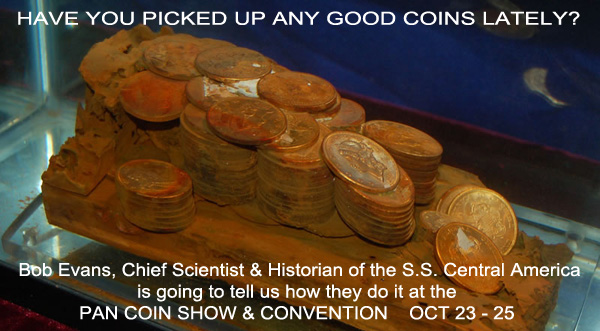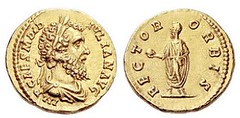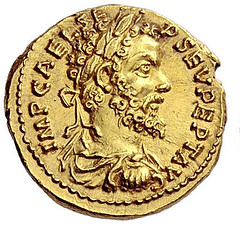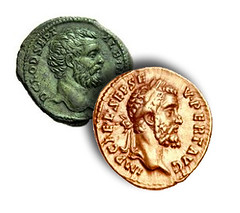
PREV ARTICLE
NEXT ARTICLE
FULL ISSUE
PREV FULL ISSUE
THE YEAR OF FIVE EMPERORSI didn't manage to get this into last week's issue, but on October 3, 2014
Mike Markowitz published another nice article in his Ancient Coin Series on CoinWeek.
The topic - the Year of Five Emperors. Without reading ahead, can you name that year in Roman
history? Here's an excerpt from the article. -Editor
By the end of 192 CE, it was clear to everyone in Rome that emperor Commodus was dangerously insane. Plots began to form. His favorite concubine, Marcia, slipped poison into his wine but he threw it up. Plan B: a wrestler named Narcissus strangled him. The next morning (New Year’s Day, 193), the Praetorian Guard proclaimed Pertinax, the elderly city manager (praefectus urbi) as emperor. The Senate joyfully confirmed him and declared the dead Commodus a public enemy, revoking his decrees and tearing down his statues. So began the Year of Five Emperors, a chaotic period that would keep the coin die engravers at Roman mints very busy indeed. Some of the rarest Roman coins were struck during the next few months, along with many available to collectors today at surprisingly modest cost. Pertinax
Considering that he ruled for just 87 days, his coinage is remarkable: six issues of gold, 11 of silver and 14 in bronze or copper at Rome, and several at Alexandria including rare types honoring his young wife Titiana and son Pertinax Junior. He raised the silver content of the denarius from 74% to 87%. His powerful, bearded portrait conveys a sense of gravitas – that untranslatable Latin term that combines seriousness, authority, and the power to command respect. It wasn’t enough to prevent his overthrow, however. On March 28, Pertinax tried to quell a mutiny of the unruly Praetorian Guard. He was killed by a javelin to the chest. Didius Julianus
Pescennius Niger
His coinage was struck at Antioch in Syria, Alexandria in Egypt, and Caesarea in Cappadocia (“Caesarea” was a popular Roman place name; like “Springfield” in the USA). Issued in haste to pay the troops, the coins often have blundered inscriptions and crude workmanship. But some are impressive, like the rare debased silver tetradrachm of Antioch. Clodius Albinus
Severus issued coins at Rome in the name of Albinus as Caesar, but the portrait is similar to that of Severus himself, and the engravers might have lacked a realistic image to work from. Coinage in the name of Albinus as Caesar included at least five types in gold (very rare), seven in silver, and 10 in bronze. Defeated in a great battle near Lugdunum, he killed himself to avoid capture. Septimius Severus
The coinage of Severus’ 18-year reign is vast in quantity and variety, but his initial issues from 193 include a handsome “Victory” aureus and a series of denarii to honor–and to pay–the 16 legions that eventually supported him. To read the complete article, see:
 Wayne Homren, Editor The Numismatic Bibliomania Society is a non-profit organization promoting numismatic literature. See our web site at coinbooks.org. To submit items for publication in The E-Sylum, write to the Editor at this address: whomren@gmail.com To subscribe go to: https://my.binhost.com/lists/listinfo/esylum All Rights Reserved. NBS Home Page Contact the NBS webmaster 
|



